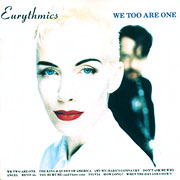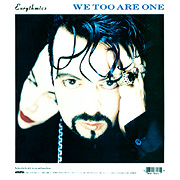
We Too Are One
Eurythmics
1989: Arista ARCD-8606

When “Don’t Ask Me Why” came out I was visiting my sister, somewhere in Oregon (probably Salem); I remember hearing the song on the radio (with surprise), and seeing on her television in the same weekend the startling video for Deee-Lite’s “Groove Is in the Heart.” Within months I was en route to London and Paris. It was a time of fascinating shifts and upheavals, and this album therefore landed on uneven ground.
I enjoyed it then and still do, but it really is an odd, standalone album, almost anchorless in a sea that’s suddenly shifting even more than usual. It almost sounds like a collection of songs, not an album per se (although perhaps that’s a self-contradictory assessment). Given the circumstances of the album’s recording, I suppose that’s not surprising. I guess anyone would have an individual opinion of it, and mine is personal and quirkily tied to the times, so I won’t elaborate here because it just wouldn’t translate. The album does, but my interpretations don’t. That’s fine.
Then again, I think that for me and for actual professional reviewers/critics this album suffers unavoidably from the weight of comparative material: this is, after all, Eurythmics’s eighth proper album, and even though every one of those other albums was distinct and seemed to have arrived out of nowhere, expectations and precedents from all of them (and D&A’s work as part of The Tourists) are almost automatically pre-positioned on one side of the scale before the album even starts playing. Perhaps that’s a reason the title and cover photography are so direct, to put approaching listeners on guard rather than let them say “oh, ANOTHER Eurythmics album…” with all the baggage implied therein for good or for bad. That’s just a speculation, though.
Production-wise, the album’s just about immaculate: even where on first listenings it seems too “clean,” later listenings reveal a discreet grittiness and a sense of bits left un-mopped-up…and then if you go back a few more times you’ll find that even the “slop” is artfully presented and may well have been originally intended. A good example of this is found near the end of “How Long,”—a track I have found compelling and punchily beautiful since I first heard it—as Annie sings the last verse and guitar/sonic chords stab from left to right in counterpoise: those stabs contain some kind of rough vocal breathing or grunt that give the stabs an intensely discreet extra bit of impact, especially as the stabs are stereophonically contained elements in themselves.
“Sylvia” I have to mention for two reasons: first, that it’s gorgeously sinister and almost gothic, with such beautiful stop-and-start poise; second, that I will probably go to my grave wondering what the HELL was going on with all those snippets of chatter that follow the end of the final chord (my favorite head-shaker being Annie saying earnestly “…every bit of it is some shade of brown…”). In any case, it’s an exquisite reminder that Eurythmics were never hit-seeking music-industry whores but could concoct this kind of dark confection with full icing on.
I must confess that until well after this album came out I had no idea who Charlie Wilson was, nor the Gap Band (though I’d heard a song or two of theirs), so a certain aspect of potential appreciation for what I was hearing was lost on me for some time. Wilson’s voice seemed to be a natural continuation of Joniece Jamison’s contribution to the Eurythmics sound as an adjunct to Annie’s voice, but more closely attuned in terms of range and “bite.” In fact there are times on this album (and especially on Boris Grebenshikov’s Radio Silence) where I’m not sure whether the wailing wildness of a sung note is Annie Lennox’s voice, Charlie Wilson’s voice, or Dave Stewart’s guitar. And it ain’t because the recording ain’t clear, lemme tell ya…. It sounds like they managed to find a vocal hinge-point for Annie’s voice and Dave’s guitar, with rich results, although I bet the most effective impression of this would have been in concert on the brief tour they did in support of We Too Are One, as is hinted at in the concert bits in the video We Too Are One and the recording of “We Two Are One” on the Eurythmics Live album.
When I read somewhere in an article about Annie’s then-forthcoming solo album Bare that she’d taken up kick-boxing as a hobby, my immediate reaction was “the woman who wrote a song called ‘You Hurt Me and I Hate You’ is KICK-BOXING???” The visual was pretty alarming. The song itself is decent, with or without the savage orchestration and paranoia-enhancing production, but it’s all a bit over the top really…probably intentionally so. (Then again, if you like your Annie Lennox anger settings amped up to 11, try a little ditty she recorded for Bare by the name of “Bitter Pill,” which makes this sound like “Kum Ba Ya” in comparison. YOWCH.)
I have a hard time imagining how “The King & Queen of America” would work as a single, even though I have its various incarnations on CD as well as vinyl, because it’s a beefy track that works well in full-quality stereo and doesn’t seem to be built for cheap-radio-speaker play. I know that Dave & Annie used to keep that sort of variance in mind as they reviewed potential mixes of their work, so I can only assume that they decided to go with this song “as is” for some controlled contextual play; it sure doesn’t seem to suggest itself for casual car-radio encounters. Then again, maybe this song’s best considered in the context of its priceless video, with D&A portraying 12 pairs of iconic American (US, that is) stereotyped characters….
“Angel” I appreciate but don’t particularly enjoy, ditto “Revival,” and “When the Day Goes Down” would probably be in the same boat if it weren’t for the video of this song (half studio version and half concert delivery) on the video album We Too Are One), which gives it a much weightier import (the crucial moments before they finished that world tour and then went on indefinite hiatus as a duo). And then there’s their acoustic rendering of it (recorded exquisitely on the second Don’t Ask Me Why single), which was riveting and which proved so when they dress-rehearsed it during a hectic British TV show rehearsal and had the entire show crew watching in rapt silence.
Twelve or so years after I wrote most of the above commentary, I belatedly note that I neglected to say anything about two of the album’s best tracks—an omission probably due to them being so core to the album that I took them for granted. Those are the title-ish track, “We Two Are One,” and the album’s main single, “Don’t Ask Me Why.” The latter grew on me and is now a beloved Eurythmics song, not just in this incarnation but also (and because of this) in their acoustic, stripped-down rendering of it on the CD single. It arcs back and forth between emotional extremes and takes us through a compositional journey full of orchestration and tension before fading out with still more back-and-forth, unresolved rocking (which is beautifully represented in the track’s video). And the former is just a treat, a lovely way to kick off the album with a largely bluesy tone that still has Eurythmics-electronica nerves intertwining and helixing around the track’s drumbeat spine…and it does so right out of the gate with the unusual device of Charlie Wilson imitating a harmonica by the use of his hands and voice…a gimmick Lennox used to surprisingly good effect 26 years later in her Grammys duet with Hozier.
The album’s opener is arguably an affirmation of D&A’s interrelationship as artists but can also be embraced by any number of people in relationships (well, when they’re affirming it, anyway). Personally I love how it kicks off the album with a bit of down-and-dirty, easy soulfulness and, unusually, a positive tone. Not that the rest of the album is negative or pessimistic or whatever, but this starts things off on a sharp and bright beat that still carries undertones of doubt and depression as one should expect of a Eurythmics product. I wasn’t among the rare few who got to see Eurythmics tour with this album, as they intentionally played to smaller venues in general, but what I’t seen and heard of recordings from that I can see that they ratcheted the power up a few more notches in performance, especially to bring the song’s end not to a fade-out but to a climax starting with a playing-off of the “one, two/too, one, two/too” lyric ambiguity.
Were that song and the album’s title a doth-protest-too-much attempt to say that the duo was solidly unified when in fact they were straining to go different ways? Personally I don’t think so. To me, it does have such overtones but it more importantly first is a song about a relationship and second is an affirmation that these particular two have intensely intertwined personalities regardless of whether they are producing music together or not. And I’m OK with that.
I belatedly have noticed that all my previous comments have left out “(My My) Baby’s Gonna Cry.” That omission is probably because it’s not inherently a profound song as written (Stewart has said that it started off as a Sonny and Cher parody titled “You Ain’t Got Me, Babe”), and it certainly plays a role as Filler here. But its video does remind me to revisit it and reconsider it both in its temporal context (simultaneously what their sound was, and maybe what music was, at the time, and that their partnership was straining and intensely needing a break. With all that in mind, I suppose this track mostly serves for me personally as a snapshot of a moment, albeit a musically/sonically enjoyable one thanks to production touches such as the shift from the straight-ahead bulk of the song to its chrysalis phase at the end of the second chorus (where the stereophonic game starts to kick into action and the listener’s perspective gets challenged somewhat to rethink itself). All that said, I have to add that this track is much better on vinyl than in digital form. (As for those who remark that the presence of Dave Stewart singing on a Eurythmics track is a fatally bad thing, I can only say that they need to grow up. In this instance, it’s actually integral.)
One last thing about this album: Jean-Baptiste Mondino’s arresting photography for this album remains supremely Parisian and cosmopolitan-chic many years later. I was very pleased that the front and back covers featured respectively Annie with Dave as a hovering/adjacent presence slightly out of focus and then vice-versa. The images are strong in a gently abstracted way, and so are the connotations (such as that, significantly, in this stark lighting the form of each of them is partly defined by the other’s background presence).
Comments © 2005/2018 Mark Ellis Walker, except as noted, and no claim is made to the images and quoted lyrics.